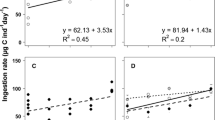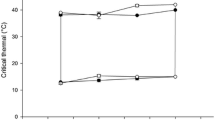Abstract
Synchronous measurements were made of the routine rate of oxygen consumption and the clearance rate of Phaeodactylum tricornutum at different exposure temperatures by specimens of the suspension-feeding gastropod Crepidula fornicata which had been acclimated to temperatures between 10° and 25°C. The results show that the cost of activity (μl O2 consumed h-1/ml seawater cleared h-1) increases dramatically in individuals exposed to short-term increases of temperature up to 30°C, especially in limpets acclimated to 10°C. The process of thermal acclimation, however, results in two compensatory adjustments in energy expenditure and uptake which profoundly affect the energetics of water transport. Firstly, the routine oxygen consumption shows lateral translation of the rate-temperature curve which results in the maintenance of a relatively uniform energy expenditure despite an increase in acclimation temperature from 10° to 25°C. Secondly, because of the form of the rate-temperature curve for filtration by C. fornicata, lateral translation in response to warm acclimation results in an increase in the maximal clearance rate. Lateral translation of the rate-temperature curves for feeding rates and for oxygen consumption in response to thermal acclimation may thus be linked to maintain a balance between energy gain and expenditure. In this way, the greatly increased cost of activity which would occur with increase of temperature in the absence of acclimation is evaded. The minimal maintenance energy requirement, and hence the greatest scope for growth and reproduction, is then adjusted to coincide with temperatures prevailing in the environment.
Similar content being viewed by others
Literature Cited
Bayne, B.L., R.J. Thompson and J. Widdows: Some effects of temperature and food on the rate of oxygen consumption by Mytilus edulis L. In: Effects of temperature on ectothermic organisms. pp 181–193. Ed. by W. Wieser. Springer-Verlag: Berlin, Heidelberg, New York 1973
———: Physiology I. In: Marine mussels, pp 121–206. Ed. by B.L. Bayne. International Biological Programme 10, Cambridge: Cambridge University Press 1976a
—, J. Widdows and R.J. Thompson: Physiological integrations. In: Marine mussels, pp 261–291. Ed. by B.L. Bayne. International Biological Programme 10, Cambridge: Cambridge University Press 1976b
Calabrese, A. and E.W. Rhodes: Culture of M. lateralis and C. fornicata embryos and larvae for studies of pollution effects. Thallasia jugosl. (In press)
Crisp, D.J. and D.A. Ritz: Temperature acclimation in barnacles. J. exp. mar. Biol. Ecol. 1, 236–256 (1967)
Halcrow, K. and C.M., Boyd: The oxygen consumption and swimming activity of the amphipod Gammarus oceanicus at different temperatures. Comp. Biochem. Physiol. 23, 233–242 (1967)
Jørgensen, C.B.: The biology of suspension feeding, 357 pp. Oxford: Pergamon Press 1966
Kinne, O.: Temperature: animals — invertebrates. In: Marine ecology. Vol. I. Environmental factors, Pt 1. pp 407–514. Ed. by O. Kinne. London: Wiley-Interscience 1970
McFarland, W.N. and P.E. Pickens: The effects of season, temperature, and salinity on the standard and active oxygen consumption of the grass shrimp, Palaemonetes vulgaris (Say). Can. J. Zool. 43, 571–585 (1965)
Newell, R.C.: Biology of intertidal animals, 555 pp. London: Elek Books 1970
—: Adaptations to intertidal life. In: Adaptation to environment. Essays, on the physiology of marine animals, pp 1–82. Ed. by R.C. Newell. London: Butterworths 1976
— and B.L. Bayne: A review on temperature and metabolic acclimation in intertidal marine invertebrates. Neth. J. Sea Res. 7, 421–433 (1973)
— and L.H. Kofoed: The energetics of suspension feeding in the gastropod Crepidula fornicata L. J. mar. biol. Ass. U.K. 51, 161–180 (1977)
Newell, R.C., L.G. Johnson and L.H. Kofoed: Adjustment of the components of energy balance in response to temperature change in Ostrea edulis. Oecologia (Berl.) (In press)
Pickens, P.E.: Heart rates of mussels as a function of latitude, intertidal height and acclimation temperature. Physiol. Zoöl. 38, 390–405 (1965)
Precht, H.: Concepts of temperature adaptation of unchanging reaction systems of cold-blooded animals. In: Physiological adaptation, pp 50–78. Ed. by C.L. Prosser. Washington D.C.: American Physiological Society 1958
—, J. Christophersen, H. Hensel and W. Larcher: Temperature and life, 760 pp. Berlin, Heidelberg, New York: Springer-Verlag 1973
Prosser, C.L.: The nature of physiological adaptation. In: Physiological adaptation, pp167–180. Ed. by C.L. Prosser. Washington D.C.: American Physiological Society 1958
—: Comparative animal physiology, 3rd ed. 966 pp. Philadelphia. W.B. Saunders 1973
— and F.A. Brown: Comparative animal physiology, 2nd ed. 688 pp. Philadelphia: W.B. Saunders 1961
Rao, K.P.: Rate of water propulsion in Mytilus californianus as a function of latitude. Biol. Bull. mar. biol. Lab., Woods Hole 104, 171–181 (1953)
—: Tidal rhythmicity and rate of water propulsion in Mytilus and its modifiability by transplantation. Biol. Bull. mar. biol. Lab., Woods Hole 106, 353–359 (1954)
Ritz, D.A. and B.A. Foster: Comarison of the temperature responses of barnacles from Britain, South Africa and New Zealand, with special reference to temperature acclimation in Elminius modestus J. mar. biol. Ass. U.K. 48, 545–599 (1968)
Segal, E., K.P. Rao and T.W. James: Rate of activity as a function of intertidal height within populations of some littoral molluscs. Nature, Lond. 172, 1108–1109 (1953)
Warren, C.W. and G.E. Davis: Laboratory studies on the feeding, bioenergetics and growth of fish. In: The biological basis of freshwater fish production, pp 175–214. Ed. by S.D. Gerking. Oxford: Blackwell Scientific Publications 1967
Wieser, W.: Temperature relations of ectotherms: a speculative review. In: Effects of temperature on ectothermic organisms, pp 1–23. Ed. by W. Wieser. Berlin, Heidelberg, New York: Springer-Verlag 1973
Yonge, C.M.: The hydrogen ion concentration in the gut of certain lamellibranchs and gastropods. J. mar. biol. Ass. U.K. 13, p. 938 (1925)
Author information
Authors and Affiliations
Additional information
Communicated by T.M. Fenchel, Aarhus
Rights and permissions
About this article
Cite this article
Newell, R.C., Kofoed, L.H. Adjustment of the components of energy balance in the gastropod Crepidula fornicata in response to thermal acclimation. Marine Biology 44, 275–286 (1977). https://doi.org/10.1007/BF00387708
Accepted:
Issue Date:
DOI: https://doi.org/10.1007/BF00387708




